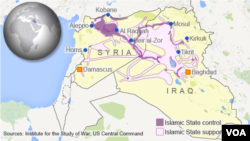At least 400 Syrian children have been recruited by the jihadist Islamic State since the start of the year in an enlistment drive partly designed to make up for a shortfall in foreign fighters traveling to join the extremist group, say local political activists.
In order to secure more child soldiers, the Islamic State has been opening branches of a youth wing, known as “Ashbal al-Khilafah,” or cubs of the caliphate, beyond its stronghold in the northern Syrian province of Raqqa to other areas it controls in Syria.
Branches have been set up recently in the towns of al-Bokamal and al-Mayadin, both in Deir Ezzor Province.
The Syrian Observatory for Human Rights, a London-based group that relies on a network of political activists for its information, says it has documented 400 children joining IS since the beginning of this year. It says the recruitment drive of child soldiers, which is against international law, is coinciding with a noticeable fall-off in the past three months in the number of adult foreign fighters joining the extremist group, possibly a result of increased Turkish interdiction of recruits transitioning through the border with Syria.
Recruiting kids
The militants running the branches of the cubs of the caliphate “work on convincing and attracting children who live near IS posts” to join the militant organization, often without the approval of their parents. The kids are sometimes recruited in public squares “when they come to see executions, whippings, crucifixions and beheadings carried out by the militants,” says Rami Abdulrahman of the Syrian Observatory.
IS also induces parents and guardians to send their sons to cub camps, where the children undergo Sharia and military courses, with the offer of cash and cars.
Much of international media attention on the use of child soldiers by the militants in Syria is focused on the children foreign fighters have taken along with them, prompted by the foreign children being showcased by the militants in propaganda videos including footage of them executing opponents or traitors. A 12-year-old French child soldier was featured in a video in March in which he shot in the forehead a man accused of spying on the group.
The children of foreign fighters appear frequently in the social media feeds of foreign fighters. Last August an Australian militant in Raqqa posted a photo on Twitter of his seven-year-old holding up a severed head with the accompanying caption,“That’s my boy.”
But activists and residents who recently fled Syria say the majority of cubs of the caliphate are local children and the militant camps they attend transform them into warriors, suicide bombers or spies. A high death toll in IS fighters is making the recruitment of child soldiers a pressing need. Last month, General Lloyd Austin, who heads U.S. Central Command, told American lawmakers the coalition bombing campaign against IS had likely killed more than 8,500 fighters.
Young fighter killed
In January, the Syrian Observatory reported IS sending teenagers to the front-lines in the prolonged battle for the mainly Kurdish Syrian town of Kobani. At least half-a-dozen of the IS dead that month in the fight around Kobani were under the age of 18.
But the recruitment of child soldiers isn't only to meet immediate needs. A recent U.N. report on war crimes in Syria warned IS indoctrination of children is crafting a “cadre of fighters that will see violence as a way of life,” leaving post-war Syria with a huge problem to overcome.
Elementary and middle schools in Raqqa were reopened this year by IS, but many local families do their best to escape surveillance to keep their children at home, fearful they will be recruited or press-ganged at school, according to a network of local activists called “Raqqa is Being Slaughtered Silently.”
American researchers Jessica Stern and JM Berger say Islamic State militants are being especially ruthless in their recruitment of child soldiers. “While children have often been victims of such manipulation in war zones, IS approached their ‘education’ as it did almost everything else - systematically,” they write in a new book ISIS: The State of Terror.
Last year, Human Rights Watch noted in an extensive report that IS militants have “targeted children for recruitment by providing military training in school settings or as part of broader education programs run by the groups. Former recruits described how leaders gave children particularly difficult or dangerous tasks and encouraged them to volunteer for suicide attacks.
“Amr,” who fought with ISIS in northern Syria when he was 15, said his unit leaders encouraged him and other children to volunteer for suicide bombing attacks. He said he signed up reluctantly, but was able to get away before his turn came up.






